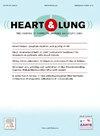Exercise-induced oxyhemoglobin desaturation is an independent risk factor for sustained nocturnal hypoxemia in adults with precapillary pulmonary hypertension: A cross-sectional study
IF 2.6
4区 医学
Q2 CARDIAC & CARDIOVASCULAR SYSTEMS
引用次数: 0
Abstract
Background
Nocturnal hypoxemia (NH) negatively impacts the prognosis of several chronic cardiopulmonary diseases.
Objectives
To assess the risk factors associated with sustained NH in adults with precapillary pulmonary hypertension (pPH).
Methods
This cross-sectional study was performed between June 2021 and June 2024. Outpatients with a hemodynamic diagnosis of pPH (Groups 1 and 4) were consecutively recruited. Sustained NH was defined as ≥ 30 % of the percentage of time spent with oxygen saturation (SpO2) <90 % during a home sleep apnea test (HSAT). Clinical, laboratory, hemodynamic, echocardiographic, functional, and exercise-related variables were collected blindly regarding the HSAT data. We considered a difference in SpO2 [resting – final] (Δ SpO2) ≥ 3 % as indicative of exercise-induced oxyhemoglobin desaturation (EID) by the six-minute walk test. Multiple logistic regression analysis was used to identify possible predictive factors for the occurrence of NH.
Results
Fifty-two pPH adults were included (71.2 % were females). Thirty-one patients (59.6 %) were classified as having NH. In the univariate logistic regression analysis, four parameters were identified as risk factors for the presence of NH: mean pulmonary artery pressure (p = 0.023), right atrial mean pressure (p = 0.037), systolic pulmonary arterial pressure (p = 0.042) and EID (p = 0.003). However, only EID was an independent predictor for detecting NH with an adjusted odds ratio of 10.590 (95 % confidence interval: 1.095–102.420); p = 0.042.
Conclusions
EID is an easily implementable risk factor for prolonged NH, suggesting that adults with pPH who experience EID have a high probability of also experiencing NH.
一项横断面研究:运动诱导的血红蛋白去饱和是成人毛细血管前肺动脉高压患者持续夜间低氧血症的独立危险因素
背景夜间低氧血症(NH)对多种慢性心肺疾病的预后有负面影响。目的评估与毛细血管前肺动脉高压(pPH)成人患者持续 NH 相关的风险因素。连续招募血液动力学诊断为毛细血管前肺动脉高压的门诊患者(第 1 组和第 4 组)。持续 NH 的定义是:在家庭睡眠呼吸暂停测试(HSAT)中,血氧饱和度(SpO2)大于 90% 的时间百分比≥ 30%。对于 HSAT 数据,我们以盲法收集临床、实验室、血液动力学、超声心动图、功能和运动相关变量。通过六分钟步行测试,我们认为 SpO2 [静息-最终] 差异 (Δ SpO2) ≥ 3 % 表明运动诱发氧合血红蛋白不饱和 (EID)。多重逻辑回归分析用于确定 NH 发生的可能预测因素。31名患者(59.6%)被归类为NH患者。在单变量逻辑回归分析中,四个参数被确定为出现 NH 的风险因素:肺动脉平均压(p = 0.023)、右心房平均压(p = 0.037)、肺动脉收缩压(p = 0.042)和 EID(p = 0.003)。然而,只有 EID 是检测 NH 的独立预测因素,其调整后的几率比为 10.590(95 % 置信区间:1.095-102.420);p = 0.042。结论 EID 是导致长时间 NH 的一个易于实施的危险因素,这表明经历过 EID 的 pPH 成人也很有可能经历 NH。
本文章由计算机程序翻译,如有差异,请以英文原文为准。
求助全文
约1分钟内获得全文
求助全文
来源期刊

Heart & Lung
医学-呼吸系统
CiteScore
4.60
自引率
3.60%
发文量
184
审稿时长
35 days
期刊介绍:
Heart & Lung: The Journal of Cardiopulmonary and Acute Care, the official publication of The American Association of Heart Failure Nurses, presents original, peer-reviewed articles on techniques, advances, investigations, and observations related to the care of patients with acute and critical illness and patients with chronic cardiac or pulmonary disorders.
The Journal''s acute care articles focus on the care of hospitalized patients, including those in the critical and acute care settings. Because most patients who are hospitalized in acute and critical care settings have chronic conditions, we are also interested in the chronically critically ill, the care of patients with chronic cardiopulmonary disorders, their rehabilitation, and disease prevention. The Journal''s heart failure articles focus on all aspects of the care of patients with this condition. Manuscripts that are relevant to populations across the human lifespan are welcome.
 求助内容:
求助内容: 应助结果提醒方式:
应助结果提醒方式:


